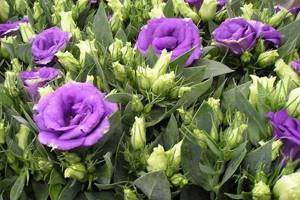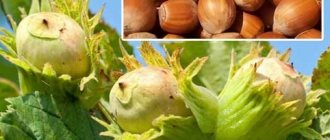The flower of Eustoma or Lisianthus is beautiful. Europe very quickly fell in love with this “Irish Rose”. It is very popular in Holland and Poland. Lately, it has become a “frequent guest” in the gardens of Russian flower growers. Eustoma does not tolerate when its root system is destroyed, therefore, it cannot be propagated by dividing the bush. And cuttings do not bring good results. You can grow this beauty only from seeds, using seedlings. Of course, you need to know some rules to get a strong, healthy and beautiful plant. But today we’ll talk about how to plant Eustoma seedlings correctly.
Types of Eustoma and popular varieties
As you know, Eustoma is very diverse. It can be terry or non-terry. Until the flower has blossomed, it is very difficult to distinguish it from rose buds, and the blossoming Eustoma looks like poppy flowers.
Let's look at some cut varieties of this plant:
- Eustoma Echo Pink Pikoti F1 is a plant about 70 cm high. The flowers are double, early flowering. The color can be either one-color or two-color. When cut, it lasts for a long time.
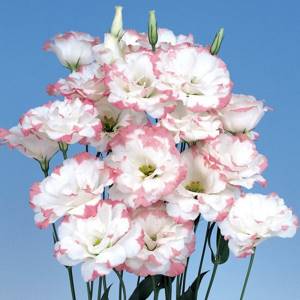
Eustoma Echo Pink Pikoti F1 - Aurora . This species is famous for its variety of colors. May have white, blue, blue or pink. The color of the petals. The plant is tall, more than 130 cm in height. It begins to bloom quite early.
- Mermaid. The species is low-growing, no more than 20 cm high. The bush is very spreading. It blooms with white, blue, pink and purple flowers.
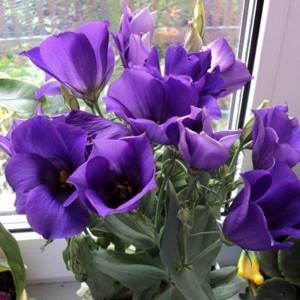
Eustoma Mermaid blue F1 - Flamenco. Tall, reaching 120 cm in height, eustoma is large-flowered, buds grow up to 8 cm. Eustoma has won the hearts of many gardeners. Moreover, this variety is not very whimsical.
- Heidi. This profusely flowering Eustoma has a medium-height stem, flowers of a predominantly simple type, and a wide variety of colors, up to 15 different options.
- Little Bell. This is a variety of low-growing Eustoma. The size of the bush is no more than 15 cm. The flowers are mostly simple, medium-sized with a rich range of shades.
Of course, these are not all varieties of this plant. There are actually a lot of them.
Description of eustoma
Known among flower growers also under the name of Russell's lisianthus, Irish, Japanese rose, Texas bell or love rose, eustoma is one of the most beautifully flowering crops. In both horticulture and floriculture, it is represented by only one species - grandiflora eustoma (eustoma grandiflorum).
Previously, three separate species were recognized in the genus Eustoma. However, joint work by employees of the Royal Botanic Gardens at Kew (UK) and the Missouri Botanical Garden (USA) to streamline the nomenclature of modern plant taxa, united the following species under a single name - Eustoma grandiflorum: Eustoma grandiflorum, Lisianthus - Eustoma Roussel's, or Russell's (Eustoma russellianum), Eustoma minor, Gentian minor, Western gentian, Blue marsh Eustoma (Eustoma exaltatum).
Eustoma grandiflora is a luxurious plant from 30 to 90 cm in height with branched shoots, simple, elegant leaves with a bluish tint and flowers reminiscent of a hybrid of roses and poppies. Up to two dozen large luxurious flowers bloom on one plant per season, and due to the fact that they open not simultaneously, but alternately, eustoma remains attractive for an amazingly long time.
The ability of buds to bloom after the flowers wither is also preserved in bouquets: when buying eustoma or displaying it in vases, you can be sure that each bud will in turn turn into a beautiful Japanese rose. Each plant looks like a bouquet: due to its specific branching, strong, but slender, fan-shaped, eustoma really seems like a bouquet planted in a pot.
Flowering of eustoma depends on the timing of sowing and begins 20 weeks after sowing. For classic garden eustomas, it starts in June-August and lasts until mid-autumn, because the plant will not stop delighting with flowers until the frost reaches -10 degrees and snow falls.
The color palette of eustoma today includes not only white, purple, pink, yellow, orange colors, but also various two-color and watercolor combinations. Compact indoor eustomas have colors that are usually clean and quite bright, while garden ones have a much wider range of colors. It even includes light green and fruity shades.
The huge assortment of eustoma and its popularity all over the world are the merit of breeders in the USA and Japan. In the West, this plant is one of the most popular cut species, but here, too, this Japanese beauty is slowly gaining ground.

Bouquet of eustomes. © ekenitr
When to sow Eustoma for seedlings
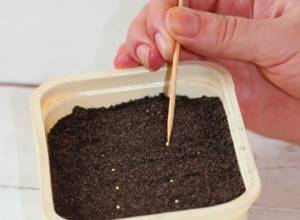
You will be able to admire the beautiful flowers of Eustoma almost only when it is grown from seedlings. The time from the first shoot-loop to the first beautiful flower takes about six months. It is clear that we cannot do without seedlings. And you need to sow Lisianthus seeds in winter, and sometimes even at the end of autumn.
There are many different opinions on when to sow seeds. Some gardeners say that the end of December and the beginning of January is the best time, while other gardeners say that Eustoma sown at the end of February, beginning of March will have time to please with beautiful flowers. When sowing seeds, it is necessary to take into account the climatic characteristics of the region of residence and the time required for seedling growth.
If Eustoma is grown as a houseplant, then you only need to calculate the time before the flowers form, and you should not pay attention to the climate.
When to sow Eustoma in the regions
- When planning to get magnificent flowers in Siberia in mid-summer, you should take care of sowing seeds in late autumn of the previous year.
- For the middle zone and Moscow region, you can plant seeds for seedlings a little later in January-February.
- Gardeners in the southern regions can plant Lisianthus in February-March.
When to sow Eustoma according to the Lunar calendar in 2021
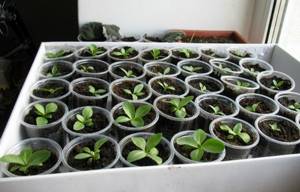
More than 20 weeks pass from germination to flowers, so you need to take care of sowing in a timely manner and do this better by focusing on the lunar calendar.
In the table, you can see which will be the best and worst days in 2021.
| Month | Favorable days | Unfavorable days |
| January | 4-7, 9, 10, 27-29 | 11, 24-26 |
| February | 1, 2, 6, 7, 26-28 | 3, 8, 9, 17, 21-23 |
| March | 1, 2, 4-8, 26, 28, 31 | 9, 19-21, 24, 27 |
Eustoma - reproduction
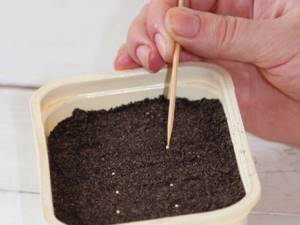
Eustoma reproduces only by seeds. Since the roots are very fragile, they cannot tolerate division. Cuttings also do not give positive results. However, propagation by seeds is possible immediately in open ground. It is enough to sow the seeds in the prepared soil (keeping a distance of 15 to 30 cm), and later transplant them into pots for the winter and keep them in the house, then they will bloom the next year.
How to grow Eustoma seedlings at home
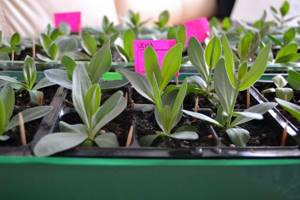
To get such beautiful flowers, you can take care of the seedlings for several months. Before sowing seeds, you need to prepare the soil, containers and the seeds themselves.
Preparing soil and containers
You can use soil already prepared from the store, it is best if it is for growing Saintpaulia. It is worth adding a little sifted sand or perlite to it. Or you can prepare it yourself using peat:
- Peat – 6 liters;
- Garden soil - 3 liters;
- Sand – 1 liter.
Whatever soil you use, you need to make sure that it is light, breathable and not acidic. To avoid acidity, you can put 1-1.5 cups of ash on a bucket of prepared soil.
Disposable containers with a lid, in which cookies and cakes are sold, are ideal as containers. But you can also buy special mini-greenhouses. These are containers, often divided into small containers with a transparent lid. And of course, peat tablets are simply great for growing Eustoma seedlings. They are already “filled” with useful microelements.
Selection of seeds and preparation for sowing

It has been said more than once that Eustoma can reproduce exclusively by seeds. This is where you need to carefully analyze your choice. You need to look at the height, so if the package with seeds states that their height is 75-95 cm, this Eustoma is grown in an open-air garden and used for cutting. But plants about half a meter tall can be grown at home.
In Russia, Eustoma is grown as an annual plant, as well as low-growing varieties, as an indoor plant.
Everyone can choose the variety according to their preference. The seed market is very wide. You can choose from simple specimens to terry ones. With petals of various colors.
Sowing Eustoma
You will have to care for Irish rose seedlings for six months, but you need to take care of additional lighting in a timely manner.
Sowing is best done in peat tablets, the diameter of which is 4 cm..
- First, the tablet is prepared by soaking it in a small amount of water. It is correct not to immediately put the tablet in a large volume of water and let it take in as much liquid as it needs. You need to place them in a container and add warm water little by little, let them absorb the moisture and add more if necessary.
- One Lisianthus seed should be placed in the tablet prepared in this way. Eustoma seeds are very small and sometimes they do not have enough strength to break through the chamber of the pill. Before sowing, you need to help the seed. The dragees are soaked for 20-30 minutes in warm water, and after soaking, the shell is broken with a thin stick.
- All seed tablets must be placed in a container and covered with a transparent lid or glass sheet.
The container is placed in a warm place, with a daytime temperature of no lower than 20-25°C, and at night the temperature should not be lower than 15-20°C above zero.
In addition to warmth, it is necessary to provide the plantings with additional lighting. The duration of daylight should be at least 12 hours. If there is insufficient natural light, the plant must be illuminated with lamps.
Caring for eustoma seedlings after germination
Proper sowing of eustoma, the best methods: video
Growing eustoma as an indoor or garden potted plant
The opportunity to cultivate luxurious eustoma as a purely indoor plant appeared relatively recently. And we are completely indebted to the Japanese flower growers, who developed special varieties of eustoma that thrive in pots. 10-20 years ago, eustoma was a miracle in the assortment of indoor plants, and it was brought indoors only to save it for the garden for the winter.
It is better to buy indoor eustomas not in the form of seedlings, but ready-made bushes in specialized flower shops. If you want to purchase several specimens along with seedlings for the garden, then make sure that you are offered a variety that is specifically suitable for potted culture. The height of indoor eustomas is limited to 15-30 cm.
Even modern hybrid indoor eustomas are grown as seasonal annuals, plants that, after colorful flowering, are easier to throw away than to try to preserve in a perennial culture. If you give the eustoma a full winter, provide extremely complex care and cool temperatures, then the plant can be grown as a biennial, but the eustoma will not become a full-fledged perennial. Another unpleasant “surprise”: indoor eustomas usually grow rapidly after purchase, increasing in size due to treatment with growth inhibitors.
For growing in pots with a stay in the fresh air in the garden from late spring to autumn, only eustomas of fairly compact size are also suitable. You can usually find seeds and seedlings on sale that indicate that they can be used for container growing. Such densities can be grown both as annuals and as perennials, purely in pots or with planting in the ground for the summer.
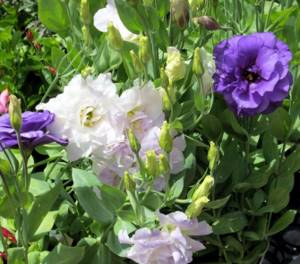
Eustoma. © typesofflower
Lighting and temperature conditions
Lighting for indoor and potted eustoma should be light and bright, but the plant should not be exposed to direct rays of the sun. In a sunny location, both the leaves and flowers of eustoma will suffer; the plant may react too sensitively to disturbances in the comfortable humidity level.
But it’s easier to choose the temperature regime: in the warm season, eustoma will feel comfortable at normal room temperatures, and potted forms will feel comfortable in the fresh air if the temperature does not drop to 10 degrees. If you do not want to throw away the plant and try to save it in winter, then after flowering and before active development begins, the eustoma should be placed in cool conditions with a temperature of about 10 degrees Celsius for indoor plants and 10-15 degrees for potted crops. Lighting during the winter should not change.
Watering and fertilizing for eustoma
Caring for eustoma in indoor and potted plants should be meticulous, but not too complicated. Water this beauty so that the substrate remains slightly moist all the time, without drying out, but also without excessive moisture. Between procedures, the top layer of soil (3 cm) should dry out, and it is advisable to drain the water from the trays immediately after watering.
Fertilizers are used only as fertilizers for flowering plants, in a standard dosage every 2-3 weeks for any form of cultivation. During cold wintering, all watering is reduced to a minimum, and fertilizing is not carried out. Spraying the plant is strictly prohibited, but increased humidity will benefit the eustoma (this is provided by placing trays with wet moss or humidifiers).
For eustoma, only warm water is used: the temperature contrast between the surrounding air and the substrate can be destructive for both indoor and garden potted eustomas.
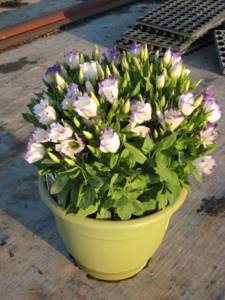
Eustoma in a pot
Transplantation and substrate
To stimulate the flowering of eustoma next year, after waking up the plant, you need to immediately replant it. The eustoma is moved to a new substrate, if necessary, increasing the pot by only a few centimeters. For eustoma, slightly acidic or neutral soil mixtures with a loose, light, permeable texture are suitable, to which a large amount of fine sand must be added.
Saintpaulia substrate is perfect for this crop. A thick layer of drainage must be laid at the bottom of the container. But the main thing is not to destroy the earthen lump during the procedure, and especially not to divide each eustoma bush, because the plant will not survive even the slightest injury to the rhizome.
Diseases and pests
Indoor eustomas suffer less from typical diseases, but at the slightest disturbance in the comfortable humidity of the substrate they are quickly affected by gray rot. Both whiteflies and thrips pose a danger to these beauties. At the same time, in order to identify the problem as early as possible, inspection of plants should be carried out as often as possible, and it is better to begin the fight immediately with the help of fungicides and insecticides.
Potted garden eustomas are just as vulnerable as those growing in the soil.
Pruning eustoma
In fact, all potted eustomas only need pinching of the top at the seedling stage. But if the plant is saved for the next year, then it is cut off before putting it into storage, leaving several internodes on each shoot.
Cutting for bouquets
Eustoma flowers are cut when at least a few “roses” open. You should not be afraid of pruning: eustoma is capable of blooming again, is actively developing and, on average, pleases with new inflorescences after 4-6 weeks. The same technique can be applied to sparse, very short flowering: pruning can be used to re-stimulate flowering in garden eustomas.
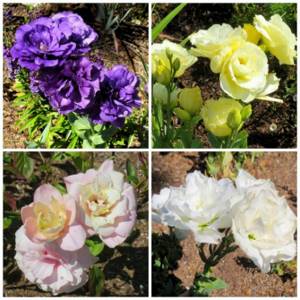
Variety of colors of eustoma. ©Kris Peterson
Seedling care
The first sprouts should be expected after about 7-10 days. They will be as thin as threads. In this state, Eustoma is very vulnerable; even a small drop of condensation can destroy a delicate sprout. Therefore, the mini-greenhouse must be ventilated and condensation removed.
When the tablets dry out (settle slightly), pour a little water into the container. The excess must be drained; the environment should not be very humid to avoid blackleg disease.
Around March, the seedlings will no longer need additional lighting; the length of daylight will be enough for her. Also, by this period it is necessary to harden the plant so that it can cope well without shelter.
This obstinate beauty does not like strong drafts and lack of water. Irrigation generally needs to be carefully regulated. She does not like waterlogging and does not like little moisture either. In the first case, there will be only foliage; if there is a shortage of water, it will shed its buds.
Picking
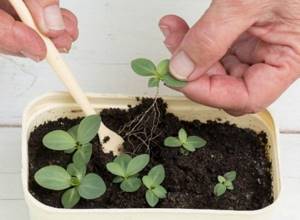
When 2-3 pairs of true leaves are formed, the seedlings should be placed in individual containers. To do this, you need to remove the protective mesh from the tablet, and place the peat lump itself in a larger container or pot and cover it with soil. The diameter of the container should be about 7 cm.
For tall plants, it will be necessary to replant them again into large pots (this operation is called “transferring”). Low varieties that will be grown in hanging pots or in balcony ones can be planted in a permanent place at this time. Transshipment should begin in the third ten days of March.
When transshipping, you will need to add 3 tbsp to the bucket. l. mineral fertilizer:
- Azofoska;
- Nitrophoska.
The soil mixture with fertilizer must be thoroughly mixed. Eustoma does not really like high concentrations of fertilizer.
When replanting, you need to pay attention to the root collar. It should be above the soil level.
To avoid stagnation of water, drainage should be placed at the bottom of the container. When watering, do not allow water to get on the leaves. Eustoma is very demanding when it comes to watering; this must be remembered throughout the entire growing period.
When to replant in open ground
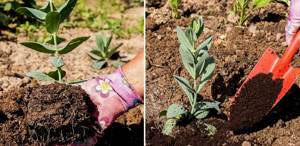
Eustoma is sent to its permanent place when the threat of return frosts has passed. This is a different time in each climate zone, but approximately mid-to-late May.
The place should be well lit with diffused light.
The soil must have good moisture and air permeability. Stagnant water is detrimental to Eustoma.
Eustoma will grow well on a sand-peat mixture. Due to the presence of peat, the environment will be acidic, so you need to add ash or lime to the soil.
Seedlings should be planted in the evening or in sunless weather.
You need to prepare a hole slightly larger than the container in which the seedlings grew. You need to put a little drainage on the bottom of the hole, then add soil, moisten everything well and plant the seedling. The gap between Lisianthus bushes should be at least 15-20cm.
The planted seedlings should be kept under cut five-liter plastic bottles for a month. After a couple of weeks, during the daytime, the cap on the bottle must be unscrewed, so the flower will get used to the surrounding temperature. During the rooting of seedlings, watering does not need to be done; it will have enough moisture from the hole. Eustoma is harmful both from waterlogging and moisture deficiency.
When 6-8 true leaves form, the seedling must be pinched so that the bush can branch better. 3-4 weeks after planting the seedlings in open ground, they need to be fed. Plantafol is best suited for this purpose. The first time you need to treat the plant with Plantafol with nitrogen, and the second time after about another three to four weeks Plantafol budding. Of course, you can also use Kemira. The concentration of the drugs should be weaker than according to the instructions.
Eustoma - care
The homeland of eustomes is the south of North America and the north of Mexico. Eustoma is part of the Gentian family. The second name of eustoma is Lisianthus. In its wild form, Eustoma is a low-growing perennial shrub. After much work by breeders, varieties with long and erect stems appeared. The plant has more than a hundred varieties varying in size, shape and color.
Appearance
The appearance of eustomas is striking in their diversity. Single forms resemble open tulips or poppies, and double forms resemble roses or peonies. Eustoma flowers grown in pots are low, with fleshy stems and leaves. Eustomas for the garden are tall, with long thin stems and bluish leaves. The flowers are double and non-double, of various shades. From deep purple to powdery or white, depending on the variety. There are also two-color varieties.
Temperature
The optimal temperature in summer is 20-25°C, and in winter 10-12°C. At night, the temperature in the garden should not be lower than 15-18°C.
Lighting requirements
Eustomas are very demanding on lighting; they need a lot of diffused light, but it is better to shade them from direct sunlight. When choosing a place for them in the garden, choose a place that is bright and protected from drafts.
In very hot summers, create artificial shade for the plant during the midday hours.
Watering mode
Proper watering is as follows: You need to water the plants at the roots and avoid getting moisture on the leaves and excessive moisture (this will lead to fungal diseases). Spraying plants is also not allowed. The watering regime differs slightly during the growth period and during the flowering period. During the growth period, it is necessary to water the plants every week.
During the flowering period, you need to adapt to the plant and avoid frequent watering, otherwise it will die.
Soils
Ideal soils are humus light loams with a neutral environmental reaction.
If the humus content is low, it must be added in a ratio of 1 part humus to 1 part soil. The main requirement for soils is good drainage to prevent moisture stagnation. If you have heavy and light soils, then you should prepare a mixture of garden soil and sand or /perlite/peat/leaf soil, taken in 1:1 proportions. The soil must be neutral, pH not lower than 6.5. Light liming will help lower the pH. If you have all three problems with your soil, then prepare a mixture of garden soil - sand - perlite - humus - lime in proportions 1: 1: 1: 1: 1/3
Fertilizers
After planting the seedlings, you need to wait about a month until they are firmly rooted and only then apply fertilizer. Afterwards, you need to apply liquid complex mineral fertilizers every two weeks. During the budding period and until the end of flowering, you need to switch to applying liquid complex fertilizer for flowering plants, with a high potassium content, and also apply it once every two weeks. It is better to start with half the dose indicated on the package; if budding is sluggish, gradually increase
Problems of growing eustoma
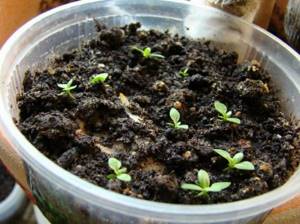
If you follow all the technology for planting and growing Eustoma, no difficulties should arise. If one rule or another is violated, diseases may appear. Such as:
- Powdery mildew;
- Gray rot;
- Fusarium wilt.
Powdery mildew is recognizable by the white coating on the leaves of the plant. This disease appears if the seedlings are poorly cared for. Over-water the plant, do not comply with the heat and light conditions. In time, the measures taken will help the plant cope with the disease. The disease should be treated with Saprol or Topsin.
To prevent parasites such as:
- Slugs;
- Fungus gnats;
- Miners;
- Whitefly;
- Aphid.
The following drugs are used:
- Fitoverm;
- Mospilan;
- Confidor.
When infected with fungi, Eustoma will become soft and begin to slowly fade.
The disease "Botrytis" will appear as gray spots on the leaves. It appears due to a lack of lighting. The plant will not die, but you won’t get any flowers from it.
Advice from flower growers
- Eustoma grows well in soil that contains bark humus and lower peat.
- Eustoma does not like excessive humidity, and drought too. The best time to water is when the soil on top dries about two centimeters.
- This flower does not like direct sunlight. She likes diffused light.
- At home, Eustoma grows better in a place with lower temperatures and good ventilation. If she is provided with such conditions, this beauty will decorate the room for a long time.
- Eustoma should only be watered with settled or boiled water.
- Irish rose also cannot tolerate severe waterlogging.
- Eustoma does not like acidic soils, so for growing it is necessary to use a mixture of soil and sand.
How to plant eustoma in the garden
Planting a flower through seeds is the most common and simplest.
Pre-sowing seed treatment
Lisianthus seeds are very small, like dust. In this regard, production facilities where seeds are packaged treat them with special substances. They form granules around the seeds. This not only makes sowing more convenient, but also helps the seeds to germinate, because the granule consists of fertilizers and growth stimulants.
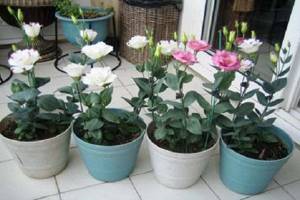
Choosing a suitable location
The flower should be planted in a place protected from wind and drafts. In the selected area, the plant should not be exposed to the scorching rays of the sun all day. It is better if eustoma grows in diffuse shade.
Timing and technology of sowing seeds
When choosing the time for sowing seed material, you need to take into account that the flowering period of lisianthus begins 15-20 weeks after germination of the first shoots. Therefore, sowing begins in winter.
In order to sow seeds, you need to prepare a container and fill it with moist soil. To do this, mix peat and sand in equal proportions. The seeds are scattered over the soil, burying them slightly into the ground. Cover the top of the container with film or a sheet of glass. They are sent to a warm place where the air temperature will not be lower than +19 degrees.
